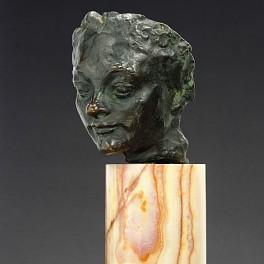BIOGRAPHY

1840 - 1917
Auguste Rodin was a French artist, who had a profound influence on 20th century sculpture. His works are distinguished by their stunning strength and realism. Rodin refused to ignore the negative aspects of humanity, and his works confront distress and moral weakness as well as passion and beauty. He was the preeminent French sculptor of his time, and remains one of the few sculptors widely recognized outside the visual arts community.
Rodin was born in 1840 into a working-class family in Paris. He was largely self-educated, and began to draw at ten. Between ages 14 and 17, he attended the Petite École, a school specializing in art and mathematics, where he studied drawing and painting. Afterwards, he applied three times to study at the renowned École des Beaux-Arts but was rejected each time. In 1858, he began to do decorative stonework in order to make his living. Four years later, the death of his sister Marie so traumatized Rodin that he entered a Catholic order. However his stay at the monastery was brief and soon he went on to pursue his dreams of being a sculptor.
In 1864, Rodin met a young seamstress named Rose Beuret, who became his life companion and was the model for many of his works. That year Rodin submitted his Man with a Broken Nose to the Paris Salon. It was rejected at first, but later accepted under the title Portrait of a Roman.
In 1870, Rodin accepted a job in Brussels. His stay there lasted six years and would prove to be a creative and inspirational time for him. In Brussels Rodin held his first exhibition, marking his debut as an independent sculptor. In 1875, Rodin traveled to Italy, where the works of Michelangelo made a strong impression on him. The trip inspired his sculpture The Age of Bronze, which was exhibited at the Paris Salon in 1877, and caused a great controversy, because the critics could not believe that Rodin had not used a casting of a live model in creating so realistic a work.
In 1880, Rodin won the commission to create a portal for a planned museum of decorative arts. He dedicated much of the next four decades to his elaborate Gates of Hell, an unfinished portal for a museum that was never built. Many of the portal’s figures became sculptures in themselves, including Rodin’s most famous, The Thinker and The Kiss. With the museum commission came artistic freedom and other opportunities. He pursued a chance to create a monument for the French town of Calais depicting an important moment in the town’s history. It became known as The Burghers of Calais and was displayed first in 1889 to general acclaim.
By 1900, Rodin has achieved the pinnacle of success. Gaining exposure from a pavilion of his artwork set up near the 1900 World’s Fair (Exposition Universelle) in Paris, he received requests to make busts of prominent people internationally. As his fame grew, he attracted many followers, including the German poet Rainer Maria Rilke, and authors Octave Mirbeau, and Oscar Wilde.
In 1903, Rodin was elected president of the International Society of Painters, Sculptors, and Engravers. During his later creative years, Rodin’s work turned increasingly toward the female form, and themes of more overt masculinity and femininity.
Rodin died on November 17, 1917, and was buried at Meudon. He willed to the state his studio and the right to make casts from his plasters. Because he encouraged the reproduction of his work, Rodin’s sculptures are represented in many collections. The Musee Rodin was founded in 1919 at the Hotel Biron, where Rodin had lived, and it holds the largest Rodin collection. His own works and other art objects he had acquired are still placed as Rodin set them.
During his lifetime, Rodin was compared to Michelangelo, and was widely recognized as the greatest artist of the era. The sense of incompletion offered by some of his sculpture, such as The Walking Man, influenced the increasingly abstract sculptural forms of the twentieth century. His most popular works, such as The Kiss and The Thinker, are widely used outside the fine arts as symbols of human emotion and character.
